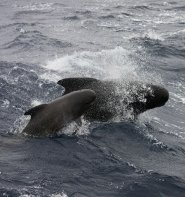 The long-finned pilot whale (globicephala melas) belongs to the dolphin family, but its behavior mimics that of large whales. Its bulbous-shaped head makes it distinctive. It looks like a cross between a whale and a dolphin. Colors range from dark gray to jet black. It may have markings of grey or white on its belly and throat. An adult male can grow to over six meters in length and weight up to 2.72 metric tons,while its female counterpart grows over 4.8 meters in length and weigh up to 1.36 metric tons. The long-finned pilot whale is named for the flippers comprising 15 to 20 percent of its body length.
The long-finned pilot whale (globicephala melas) belongs to the dolphin family, but its behavior mimics that of large whales. Its bulbous-shaped head makes it distinctive. It looks like a cross between a whale and a dolphin. Colors range from dark gray to jet black. It may have markings of grey or white on its belly and throat. An adult male can grow to over six meters in length and weight up to 2.72 metric tons,while its female counterpart grows over 4.8 meters in length and weigh up to 1.36 metric tons. The long-finned pilot whale is named for the flippers comprising 15 to 20 percent of its body length.The diet of the ling-finned pilot whale consists mainly of squid. If no squid are to be found, they will settle for octopus or fish. When feeding, dives can last up to 10 minutes and the whales will dive to a depth of 30-60 meters to locate their prey.
They are a very social mammal, traveling in large groups called pods. Leaders of the pod are adult males.
Pods of long-finned pilot whales have been known to beach themselves. They are so close-knit that when one whale strands itself on a beach the rest of the pod will follow suit. There have been reports that several hundred whales have participated in one mass beaching.
A unique aspect of the long-finned pilot whale is the fact that they have been used by the US Navy to find military equipment deep in the ocean. Due to this training ability, they are also found in exhibits in many aquariums and zoos.
Their main predator is man. Since they travel in large pods fishermen can catch many of them at a time. Other predators include large sharks and killer whales. The whale isn't considered endangered, but their numbers have been depleted in some areas of the world.
These whales are a unique mammal. If you have a chance to catch a glimpse of one either in the wild, or in a zoo exhibit, be sure to utilize it and see this dolphin-like whale.
Picture of the Long-finned pilot whale by Mmo iwdg, licensed under GNU Free Documentation License
The Long-finned pilot whale is listed as Least Concern (LR/lc), lowest risk. Does not qualify for a more at risk category. Widespread and abundant taxa are included in this category, on the IUCN Red List of Threatened Species
Namings for the longfinned pilot whale
A young / baby of a longfinned pilot whale is called a 'calf'. The females are called 'cow' and males 'bull'. A longfinned pilot whale group is called a 'gam, pod or herd'.Countries
Algeria, Argentina, Australia, Belgium, Brazil, Canada, Chile, Denmark, Falkland Islands (Islas Malvinas), Faroe Islands, France, French Southern and Antarctic Lands, Germany, Greenland, Heard Island and McDonald Islands, Iceland, Ireland, Italy, Libya, Malta, Mauritania, Morocco, Namibia, Netherlands, New Zealand, Norway, Peru, Portugal, South Africa, South Georgia and the South Sandwich Islands, Spain, Sweden, Tunisia, United Kingdom, United States and UruguaySome facts about the
Long-finned pilot whale
Adult weight : 1060 kg (2332 lbs)
Maximum longevity : 60 years
Female maturity :2470 days
Male maturity : 4380 days
Gestation : 450 days
Weaning : 812 days
Litter size : 1
Weight at birth : 109.667 kg (241.2674 lbs)
Mortality rate doubling time : 10 years

Custom Search